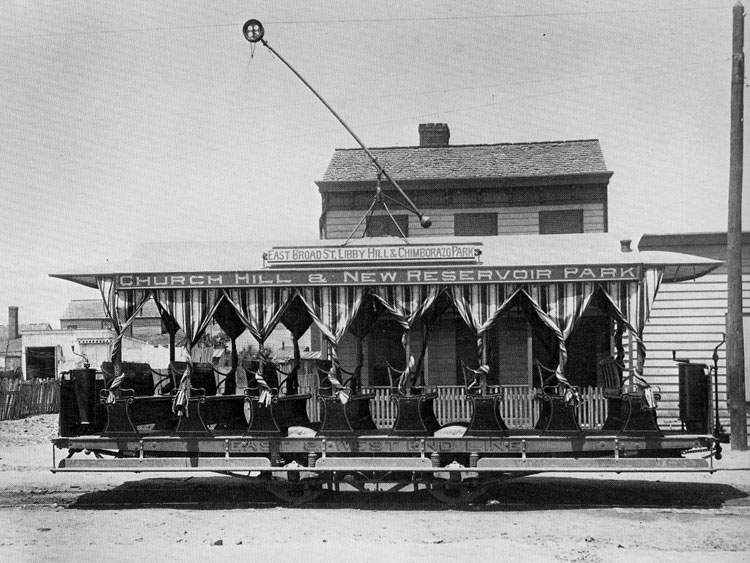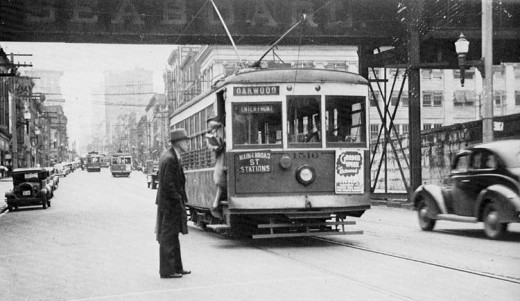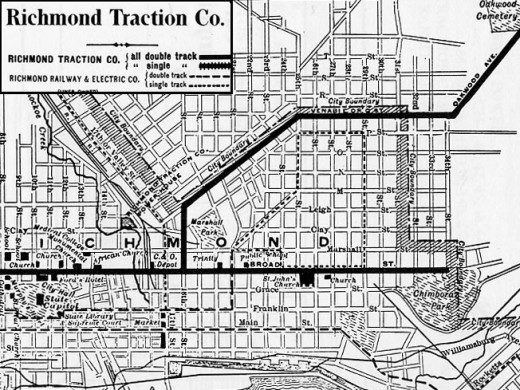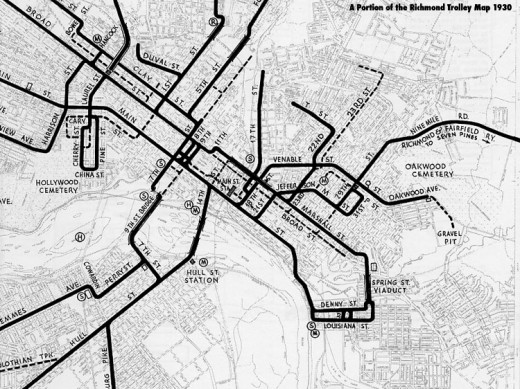RECENT COMMENTS

A history of Richmond’s trolleys
Early undated photo of the Church Hill & New Reservoir Park car (pre-1900)
I recently picked up Carlton McKenney’s Rails in Richmond (Interurban Press, 1986). Having always been fascinated that there used to be trolley lines all over the city, I couldn’t pass up this history of Richmond’s horse-drawn and electric trolleys.

Oakwood-bound car on Main Street in front of Main Street Station (1939)
The book goes into great detail explaining the beginning of Richmond’s trolleys and the various changes over the 62 year life-span of this unique part of the city’s past. There are contemporary newspaper articles (Father of the Trolley [Richmond Times-Dispatch, Dec.29, 1935] and You’ve Missed the Last Trolley [Richmond Times-Dispatch, Nov.27, 1949]) that give the story if you want a shorter version than the book provides.
Rails in Richmond has some wonderful pictures and maps. Unfortunately, with the exception of one photo from Marshall and 21st Streets from 1892, there aren’t any pictures from Church Hill in a currently-identifiable setting. This is surprising given how many photos of the trolley cars themselves have Church Hill or Chimborazo on the marquee.
The maps are fascinating in their own right. The dark lines running up Jefferson Avenue and Venable Street are enticing. Especially mysterious is the ‘discontinued’ line on 23rd Street on the 1930 map. This line, set up by the Fairmount Traction Company (incorporated in 1896), ran parallel to a 22nd Street line but went much farther north. This explains why 23rd Street north of Carrington is so wide, I guess.
Having both lived in New Orleans and recently visited San Francisco, I’ve known working trolley lines being used by people on a daily basis. The experience is definitely different than riding the bus… I can’t imagine how the trolley lines would have held up over the city’s more trying years, but I so wish that Richmond had been able to to preserve some of this.








There are MANY trolley photos available at this richmond city watch thread. That page can be very slow to load.
There are also a ton of Richmond and other trolley photos available at Dave’s Electric Railroads – Virginia.
The Richmond trolley system was known as the Richmond Union Passenger Railway. In 1992 the IEEE, Institute of Electrical and Electronics Engineers, Inc., dedicated a Historical Milestone for the Richmond electric street railway system. The IEEE historical milestone plaque is inside the VCU School of Engineering building. You can learn more at the IEEE History Center website. The IEEE Richmond Section has over 750 local members. The IEEE Richmond Section Blog keeps local IEEE members and Richmond area citizens up to date on the latest technologies.
RTD 11/13/06 – First successful electric trolley system built here
the electric trolley system (business entity) still exists today, only know as va power, oops, dominion
I can remember my mom telling me stories about riging the trolley for a nickle. At Christmas time, she would ride downtown and look in the windows of Miller and Rhodes. I guess those were the days.
richmond.com’s Who Killed the Electric Streetcar? is a good, concise history of the electric streetcar in Richmond.
A few mor points about Who killed Richmond’s Streetcars. While McKenney’s book suggested that post WW II Richmonders wanted to see the demise of the cars that’s only part of the story. The company themselves is also to blame for their failure to modernize the system to any degree. A number of cities had already adopted the President’s Conference Car (PCC) as early as 1936. For a number cities these quiet, power cars were an effective answer to buses and in many cases out performed them. It’s hard to imagine now, but in the 1940’s buses lacked automatic transmission and were not nearly as powerful as they are today. However, when compared to the Richmond trolleys, which dated from the 20’s and before they were the last word in modern city transit.
One vehical Richmond’s transit operators did consider, but do to the adoption of the one-way street patterns never implemented, was the trackless trolley or electric trolley bus (ETB). In a recent letter to GRTC head Ron Lewis I proposed that Richmond might look at ETB’s as part of its trnsportation mix. In part the letter said,”
The electric trolley bus (sometimes called the trolley coach or trackless trolley) combines the advantages of traditional streetcar technology with the flexibility of a motor coach. Operated from an overhead power source these buses share application of 600-750 volts direct current (dc) found in both office and industrial complexes for use in elevators, cranes or other electrical devices. In fact, 750 volts dc is the standard for many electric transit systems, including Washington’s Metro.
While some might raise aesthetic objections to the overhead cables employed they nonetheless serve as guide to the route since potential riders can see where the vehicles operate. One of the most common complaints leveled against transit operators is the roadside “bus stop†signs give little indication where the line actually runs.
Page 2 – Trolleybus
Currently, in the U.S., there are five trolley bus systems located in such diverse cities as Seattle, Boston, Philadelphia, San Francisco and Dayton Ohio. In each case their quiet performance, coupled with sufficient power for gradient operations have outweighed the use of traditional diesel technology. In fact, it was these environmentally desirable
characteristics that saved Dayton’s trolley bus system from extinction more than a decade ago. They have now rebuilt their fleet with 57 new trolley buses acquired from the Czech builder Skoda in 1999/2000. Boston has also modernized its trolley bus fleet for its five Cambridge lines.
Any number of route combinations could be considered candidates for possible trolleybus conversion. Suggested routes for conversion include 13 Main Street/Churchill, 16 Westhampton or the Broad Street corridor. Since 13 and 16 are under review this might be ideal for a phase one conversion. For those advocating dedicated bus ways it should be noted that in 1995 Quito Equator opened such a dedicated trolley bus system using
reserved roadways for these vehicles. For portions of the routes not initially placed under the wire a dual service vehicle could be employed. Currently, Seattle operates some 236 Breda trolleys, equipped with both Westinghouse motors and Detroit Diesel 6v-92 engines, on all portions of its system.
I closed by saying,” Only through building capacity on an incremental basis can we begin to move people out of automobiles and on to transit with any degree of regularity. Thus, the trolley bus becomes a perfect vehicle to build ridership and infrastructure necessary to support larger more complex transportation operations.
Let hope this might bring electric transit back to Richmond.
Check out this early photo ( I own the glass plate negative) of Richmond trolley cars.
http://freepages.history.rootsweb.ancestry.com/~dickbolt/TrolleyHorseCars.jpg
Richmond early trolleys.
Dick,
Great photo…do you happen to know where this is specifically?
Hi – I am working with the Richmond Trolley Company to offer trolley tours of the City starting December 1, 2011. I would love to connect with you, and link to this article and your photos, as well the one owned by Dick Bolt to help get the Richmond Trolley story out there as we gear up for our grand opening. Any contact info, resources or permissions would be greatly appreciated!
Thanks!
Jessica Borsits
Buford Creek Consulting
Hey Jessica,
None of these photos/maps are mine to give permission to share. They are all from Carlton McKenney’s book, you’d have to follow up that way.
You are certainly welcome to link to this page, as well as any others that might be interesting to you. All of the posts tagged “trolley” are here: http://chpn.net/news/tag/trolley/
My email is murden@gmail.com if you want to get in touch.
I have my grandmother’s 1934 diary. She had travelled to RIchmond from the Shores area of Fluvanna County to visit her mother-in-law. The entry reads:
March 16: Friday
Went to Richmond. Had to walk to station. Got a permanent. Went to see Mrs. Bugg found her much better but yet in bed.
Witnessed an awful scene one morn St. A St. car ran wild down Main St. Hill hitting everything in its path injuring scores of people.
Dad met me and Phil brought me home.
Is there any information available on this loose car?
Great article. I am also deeply saddened by the loss of our trolleys. It seems that mayor Jones is considering bringing them back in his new plan for sustainable development. More info can be found on ArchitectureRichmond.com.
Here is a link to the article:
http://architecturerichmond.com/2012/04/22/current-mayor-jones-green-plan-supports-trolleys/
Thanks,
D.OK.
WCVE / WCVW is re-broadcasting an old (1980s?) program called Richmond Memories tonight, and there is a segment on the streetcars. If you are reading this on 12/4, tune in to WCVW at 9:59pm .
#14… that has been a plan ongoing for several years now and like any of the “city” plans, often never materialize. But because of traffic, bus drivers hogging the roads, and parking especially near bus stops, I would say some sort of “fixed” track system would be of benefit here.
I don’t have a picture I have a horse trolly bell embossed richmond city rr co.